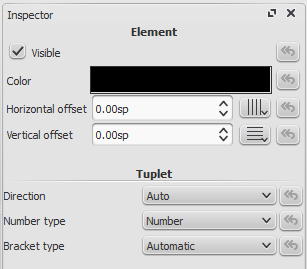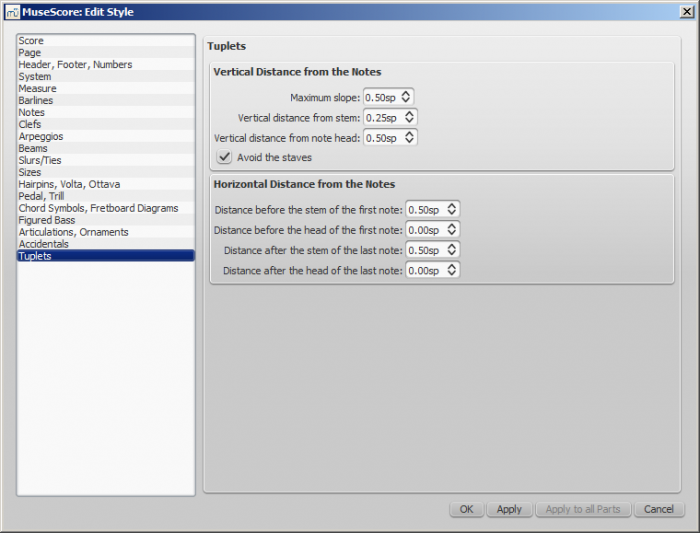Poikkeusjaot
Tuplets are used to write rhythms beyond the beat divisions usually permitted by the time signature. For example, a sixteenth note triplet will divide an eighth note beat into three sixteenth notes instead of two:

In 6/8 time, an eighth note duplet will divide a dotted quarter note into two eighth notes instead of three:

Create a tuplet
The exact method of tuplet entry depends on whether you are starting off in note input mode or "normal mode" (i.e. not in note input mode). We'll start off with a simple example: the creation of an eighth note triplet.
Create a triplet in normal mode
-
Select a note or rest that specifies the full duration of the desired triplet group. In the case of an eighth note triplet, you will need to select a quarter note or rest—as in the example below:

-
From the main menu, choose Notes→Tuplets→Triplet, or press Ctrl+3 (Mac: ⌘+3). This will give the following result:

-
The program automatically changes to note-input mode and selects the most appropriate duration—in this example an eighth note. Now enter the desired series of notes/rests. For example:

Create a triplet in note input mode
- Ensure you are in note input mode (press N).
- Navigate to the note/rest (or blank measure) where you want the triplet to start (use the left/right arrow keys as required).
- Select a final duration for the whole triplet group. In the case of an eighth note triplet, click on the quarter note in the note input toolbar (or press 5 on the keyboard).
- From the main menu, choose Notes→Tuplets→Triplet, or press Ctrl+3 (Mac: ⌘+3). This creates a triplet number/bracket and appropriately divides the original note/rest (see image above).
- The program automatically selects the most appropriate duration—in this example an eighth note—allowing you to immediately start entering the desired series of notes/rests.
Create other tuplets
Most other tuplets can be entered similarly, by substituting the general create tuplet command – Ctrl+2–9 (Mac users Cmd+2–9) – in the above series of steps: this will create tuplets ranging from a duplet (2) to a nonuplet (9). For more complex cases, see below.
Custom tuplets
To create other tuplets than the default options (e.g., 13 sixteenth notes in the space of one quarter note):
- Enter/select a note or rest equaling the total duration of the tuplet.
- Open the Create Tuplet dialog from the menu: Notes→Tuplets→Other...
-
Select the desired number ratio (e.g. 13/4 for thirteen sixteenth notes in the space of a quarter note) under "Relation" in the "Type" section. Specify "Number" and "Bracket" using the radio buttons in the "Format" section.

-
Click OK to close the dialog.

Delete a tuplet
To delete any tuplet, select the number/bracket and press Del.
Settings
To customize the appearance of a single tuplet, you can change its properties in the Inspector. You can also change the general style for all tuplets in a score.
Inspector
To change the display properties of a tuplet, select the tuplet number, or bracket, and use the Inspector.

If neither the number nor the bracket is shown, select a note from the tuplet, then use the Tuplet button in the Inspector to see the above dialog.

For Direction, choose Auto to place the bracket on the same side of the note heads as the stem, or beam. Choose Up, or Down to explicitly place the bracket above or below the note heads, respectively, regardless of the stem, or beam position.
For Number type, choose Number to show an integer, Relation to show a ratio of two integers, or Nothing to show no number at all.

For Bracket type, choose Automatic to hide the bracket for beamed notes and show the bracket if the tuplet includes unbeamed notes or rests. Choose Bracket, or Nothing to explicitly show, or hide the bracket, respectively.
Style
Go to Style → General... and select Tuplets. It enables you to change all tuplet properties.

Two adjustments are possible: Vertical and Horizontal
- Vertical adjustment has three options with values in space units and one (un)ticked option
- Maximum slope: default value is 0.50; range is from 0.10 to 1.00
- Vertical distance from stem (see (2) below): default value is 0.25; range is from -5.00 to 5.00
- Vertical distance from note head (see (3) below): default value is 0.50; range is from -5.00 to 5.00
- Avoid the staves: by default ticked
- Horizontal has four options with values in space units
- Distance before the stem of the first note (see (5) below): default value is 0.50; range is from -5.00 to 5.00
- Distance before the head of the first note: default value is 0.00; range is from -5.00 to 5.00
- Distance after the stem of the last note (see (6) below): default value is 0.50; range is from -5.00 to 5.00
- Distance after the head of the last note: default value is 0.00; range is from -5.00 to 5.00

External links
- How to create triplets and other tuplets
- Tuplet at Wikipedia
- The User Guide to Tuplets in MuseScore [video]